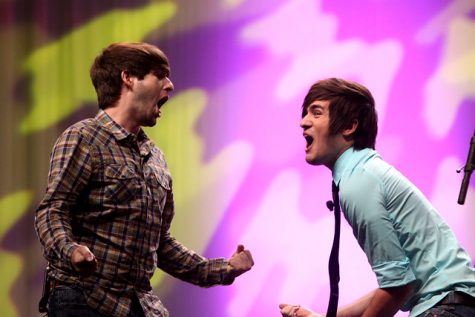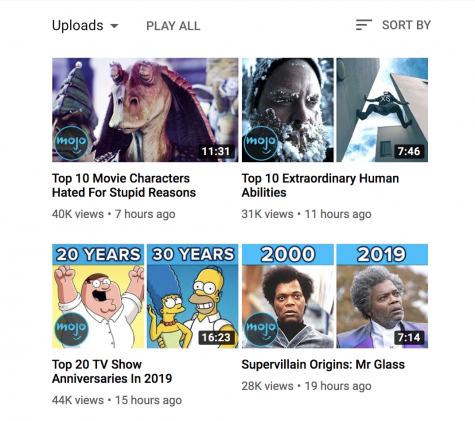“Broadcast Yourself”: The shift from personalities to companies on YouTube
Photo taken from “Me at the zoo” on YouTube
The first YouTube video, “Me at the zoo”, was posted on Apr. 23, 2005, and features co-creator Jawed Karim.
April 16, 2019
Today, YouTube is a household name, essentially replacing TV as the classic parental scapegoat for their children’s rotting minds. However, the YouTube that was created 13 years was very different from that of the present day.
The YouTube website was activated and developed over the course of 2005 by former PayPal employees Chad Hurley, Steve Chen, and Jawed Karim. Their intention was to create a simple video-sharing website, not even considering the possibility of monetization. But by July 2006, over 65,000 videos were being uploaded per day, with creators like Smosh, Ryan Higa (nigahiga), and Lucas Cruikshank (FЯED) coming into prominence for their dynamic and fast-paced sketches, playing silly characters and often relying on physical humor. The technical quality of these videos left something to be desired, but their simple, charming humor was enough to make the channels wildly successful.

Ian Hecox (left) and Anthony Padilla (right) were the two original members of Smosh, the most-subscribed YouTube channel between 2007 and 2008.
Companies and other organizations began taking note of YouTube’s success. On Nov. 13, 2006, Google Inc. finalized their deal to buy YouTube for $1.65 billion in Google stock. The same year, Time Magazine featured a YouTube screen with a mirror as its “Person of the Year”, citing the influential power of the website’s originators and content creators.
From that point onward, YouTube only continued to grow. In 2007, the company decided to take advantage of the site’s popularity, introducing advertisements in the videos of certain channels in order to increase revenue for both the company and those content creators. Sketch content remained popular, with more niche YouTubers like beauty gurus and gamers coming into prominence as well.
Over this time period, the evolution of YouTube seemed slow and steady, with the rise and fall of different personalities. But this was key—the content was created and directed by ordinary people, who made their earnings through their talent, dedication, and ability to entertain. However, the behind-the-scenes workings of the YouTube algorithm would lead to widespread complaints from content creators and audiences alike, saying that the company was undermining this spirit to unfairly promote certain content.
For instance, in 2012, in what YouTuber Matthew Patrick cites as “the most radical change in the site’s history”, YouTube replaced their view-based system with a system based on watch time, resulting in exaggerated success for “Let’s Play” gaming videos and the subsequent surge of popularity for gaming channels that did not die down until 2015. This was a departure from YouTube’s former focus; although gaming videos still showcased the content creator’s personality, they were more focused on the game itself, and many argued that no particular talent or skill was necessary to record oneself playing a game and thus achieving undeserved success on YouTube.
This was one of many changes to the YouTube algorithm over time that raised issues with many of the content creators and, intentionally or not, began putting more power in the hands of companies on YouTube, who were taking increased interest in the site. The watch-time system encouraged compilation videos, leading to the frequent recommendation of channels of organizations like WatchMojo that simply commented on other people’s content rather than truly creating their own.

Even the channels headed by “personalities” are often supported by or a part of larger companies, such as Defy Media, which owned channels like Smosh, Clevver Media, and Screen Junkies before its collapse in late 2018; T-Series, which has been battling with gamer PewDiePie for the title of most-subscribed YouTube channel; and Team 10, a self-described social media talent managing company created by Jake Paul.
Of the three, Defy Media is the most representative of the role of large companies on YouTube in general, at least in the United States. Viewers may be completely unaware of the company’s influence, as the channels appear to operate more or less independently, both of any company and of any other channels owned by the same company. Oftentimes, the only sign of a company’s influence comes from higher quality resources like fancy sets and props, or an alteration in the type of content the channel produces. For instance, after being acquired by Defy Media in 2011, Smosh began making gaming content, animated videos, and in 2015 gained five more regular cast members and started a new sketch series.
Then there are companies like T-Series that are obviously present in the channels that they own, although this seems to be more common internationally than in the U.S. T-Series in particular has received great viewership in South Asia, since the company is based in India, which in itself has earned them many subscribers due to India having the world’s second-largest online population. In addition, T-series receives 40 percent of their channel traffic from outside India, including 12 percent from the U.S.
Team 10 is its own kind of beast. From the outside, it seems like less of a company than Jake Paul making an excuse to live in a mansion with a bunch of his friends and act up. However, Shane Dawson’s documentary series “The Mind of Jake Paul” gave viewers a look into the more cutthroat, business side of the whole operation, that has led to huge fallouts between former friends. Jake Paul and those associated with him have a strong reputation among very young audiences, who likely fail to understand that they may see a personality onscreen, but that that person’s actions are driven by business goals and as such cannot necessarily be taken at face value.
In addition, other controversies with Logan Paul, Jake Paul’s brother, have also influenced YouTube to further alter their monetization policies.
The evolution of successful YouTube channels from featuring fast-paced sketches and likeable personalities to being dominated by faceless companies, while not inherently malicious, has had detrimental consequences that speak to the overall corruption of the site over time. However, it seems that less technologically advanced content produced entirely by ordinary people is on the rise again, looking at popular young YouTubers like Emma Chamberlain, which will surely have consequences of its own. In any case, YouTube is truly a social media platform unlike any other, and it will be interesting to see how the site continues to grow and change over time.


